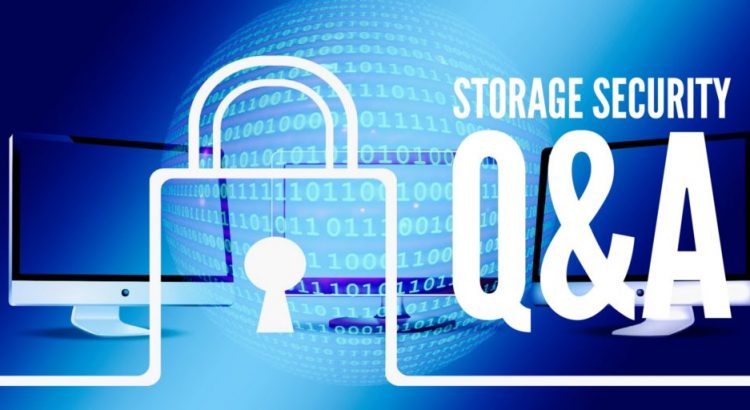Truly understanding storage security issues is no small task, but the SNIA Networking Storage Forum (NSF) is taking that task on in our Storage Networking Security Webcast Series. Earlier this month, we hosted the first in this series, “Understanding Storage Security and Threats” where my SNIA colleagues and I examined the big picture of storage security, relevant terminology and key concepts. If you missed the live event, you can watch it on-demand.
Our audience asked some great questions during the live event. Here are answers to them all.
Q. If I just deploy self-encrypting drives, doesn’t that take care of all my security concerns?
A. No it does not. Self-encrypted drives can protect if the drive gets misplaced or stolen, but they don’t protect if the operating system or application that accesses data on those drives is compromised.
Q. What does “zero trust” mean?
A. “Zero Trust” is a security model that works on the principal that organizations should not automatically trust anything inside their network (typically inside the firewalls). In fact they should not automatically trust any group of users, applications, or servers. Instead, all access should be authenticated and verified. What this typically means is granting the least amount of privileges and access needed based on who is asking for access, the context of the request, and the risk associated.
Q. What does white hat vs. black hat mean?
A. In the world of hackers, a “black hat” is a malicious actor that actually wants to steal your data or compromise your system for their own purposes. A “white hat” is an ethical (or reformed) hacker that attempts to compromise your security systems with your permission, in order to verify its security or find vulnerabilities so you can fix them. There are entire companies and industry groups that make looking for security vulnerabilities a full-time job.
Q. Do I need to hire someone to try to hack into my systems to see if they are secure?
A. To achieve the highest levels of information security, it is often helpful to hire a “white hat” hacker to scan your systems and try to break into them. Some organizations are required–by regulation–to do this periodically to verify the security of their systems. This is sometimes referred to as “penetration testing” or “ethical hacking” and can include physical as well as electronic testing of an infrastructure or even directing suspicious calls and emails to employees to test their security training. All known IT security vulnerabilities are eventually documented and published. You might have your own dedicated security team that regularly tests your operating systems, applications and network for known vulnerabilities and performs penetration testing, or you can hire independent 3rd parties to do this. Some security companies sell tools you can use to test your network and systems for known security vulnerabilities.
Q. Can you go over the difference between authorization and authentication again?
A. Authorization is a mechanism for verifying that a person or application has the authority to perform certain actions or access specific data. Authentication is a mechanism or process for verifying a person is who he or she claims to be. For example, use of passwords, secure tokens/badges, or fingerprint/iris scans upon login (or physical entry) can authenticate who a person is. After login or entry, the use of access control lists, color coded badges, or permissions tables can determine what that person is authorized to do.
Q. Can you explain what non-repudiation means, and how you can implement it?
A. Non-repudiation is a method or technology that guarantees the accuracy or authenticity of information or an action, preventing it from being repudiated (successfully disputed or challenged). For example, a hash could ensure that a retrieved file is authentic, or a combination of biometric authentication with an audit log could prove that a particular person was the one who logged into a system or accessed a file.
Q. Why would an attacker want to infiltrate data into a data center, as opposed to exfiltrating (stealing) data out of the data center?
A. Usually malicious actors (hackers) want to exfiltrate (remove) valuable data. But sometimes they want to infiltrate (insert) malware into the target’s data center so this malware can carry out other attacks.
Q. What is ransomware, and how does it work?
A. Ransomware typically encrypts, hides or blocks access to an organization’s critical data, then the malicious actor who sent it demands payment or action from the organization in return for sharing the password that will unlock the ransomed data.
Q. Can you suggest some ways to track and report attacking resources?
A. Continuous monitoring tools such as Splunk can be used.
Q. Does “trust nobody” mean, don’t trust root/admin user as well?
A. Trust nobody means there should be no presumption of trust, instead we should authenticate and authorize all users/requests. For example, it could mean changing the default root/admin password, requiring most administrative work to use specific accounts (instead of the root/admin account), and monitoring all users (including root/admin) to detect inappropriate behavior.
Q. How do I determine my greatest vulnerability or the weakest link in my security?
A. Activities such as Threat Models and Security Assessments can assist in determining weakest links.
Q. What does a ‘trust boundary’ mean?
A. Trust boundary is a boundary where program data or execution changes its level of “trust”. For example, Internet vs intranet.
We are busy planning out the rest of this webcast series. Please follow us Twitter @SNIANSF for notifications of dates and times for each presentation.

One thought to “A Q&A to Better Understand Storage Security”